1999.04.30
Terence Riley, MoMA
Complex Geometries: Plotting a Course
presented 30 April at the "Digital Translations" symposium
University of Pennsylvania Graduate School of Fine Arts
The first several minutes of Riley's address were not recorded, therefore the beginning of the text here does not represent the beginning of the address.
| |
Failures are much more unpopular in architecture than in other fields. We have to become much more comfortable with experimental failures in architecture. Especially in schools it is really important to establish an ethic of experimentation, for failure is not perceived as part of the process. Critics who lead students to believe that for a project to be considered a success, with neither a clear intention nor any way of measuring its performance, are encouraging architectural culture incapable of criticality. I shouldn't say just critics of students but critics of practicing architects. To have a critical culture in architecture there has to be much more of a kind of reality check going on.
I think we should be doing experimental things. We should be playing, and we should be experimenting, and we should recognize that the likelihood of an experiment being a success is usually fairly low. We should recognize when something's a failure. We should drop it. We should move onto something else. And I think this is an ethic that is very much part of other disciplines, but is not always part of architecture, and I think it has to become one.
While play should become more important in architecture, it should not reduce the importance of work. No one involved in the process of designing and construction of a building works harder than the architects. No one probably sees less proportionally in financial compensation. However, architects have traditionally had other kinds of compensation -- they were the only ones who really could claim that their buildings were their work. [For example,] you don't get lighting designers or lighting consultants who could claim that that building is their work. They got a piece of it. The landscape architect, it's not their work. The structural engineer, it's not their work. It's the architect's work. And if they're then paid poorly for it, they certainly become rewarded in a kind of very meaningful practice, an enviable practice, an enviable kind of professional way.
The architects were the ones who were allowed the real thrill that directing the final design affords. In exchange for total control architects accept a total responsibility, for better or worse. In recent years this has begun to change for a number of different reasons. First, this peculiar system of liability in this country. Architects are becoming concerned about taking the kind of responsibility for their work that they've traditionally taken because of lawsuits and the like. And I have no solutions to this terrible situation. All I know is the result is very negative when architects have the incentive to not remain "in control" or "in charge" of the design all the way through -- in construction, in designing the building, in supervising the work, to imagining how the thing will be built. All these things are comprehensible of a responsibility.
And you might say that this comprehensive responsibility is actually a thing of the past. This is old fashioned. The law business reflects this: you have a lawyer for your divorce; you have a lawyer for your real estate; you have a lawyer for this; you have a doctor for your intestines; you have a doctor for your brain; you have a doctor for. . . No body takes on this kind of liberal education, this large picture of responsibility like architects do. I also don't think that if we go that route -- where the whole thing is sort of specialized -- I can't see how that is going to produce the kinds of works of architecture that throughout history have moved people and that have been considered cultural achievements.
The other thing that I see chipping away at this erosion, (if we don't know how to play we're also moving away from work in a certain sense), is the emergence in the last decade or so of a distinction between architecture firms that execute buildings and architecture firms that design buildings. You very much now have a kind of separation of activities where firms design buildings, and once they're designed they are then handed off to another kind of firm which do all the working drawings and take on a lot of responsibility. Then there's some kind of overlap and every kind of permutation in-between. But certainly [this is] an ethic that says what's most important is that the design architect describes how it's going to look; that the other architect's responsibility is to build it. Sometimes this is the choice of the architect. Peter Eisenman, of course, famously has said that he doesn't care how it's built. It's all sheet-rock and all something or other, and the fact is that when architects discharge this responsibility, and they say that the only. . .
The design architects have actually created now this second kind of firm that doesn't really design, they just kind of build things. And they have created, I think, to the detriment of all of us this option. This option is now being exercised by developers, and architects, having given away some responsibility, I think will learn to rue the day. One very well known architect, shall we say the dean of American architects, has complained that his clients now try to control him, that they come to him, and what they really want is for him to design the facade of the building. Of course, this architect has never been concerned with anything but the design of the facade and the shape of the building, but he complains now that he is being encroached upon by an interior architect who has been hired by the developer [and] by a production architect, and the developer is determining who all these people are. The architect is no longer the responsible person. Well, quite frankly, this is the kind of practice situation created by architects who cut this responsibility, [creating to option] that somehow you can design the building but some else could figure out how to build it.
This is creating some unpleasant scenarios, and, I'll repeat, it doesn't seen likely to me that the architectural promise, which these new technologies represent and will be talked about in the next day, will ever be fulfilled without a renewed commitment to the idea of professional responsibility. Collaboration will be vital, but I don't think great works of architecture can be achieved when the architect is simply a member of a team. That goes against a lot of the deep felt contemporary theories about work, again, I admit that, but I think there's nothing wrong with learning more sophisticated ways of working as a team. But I don't think the marketer and the real estate person can be considered to be equal members of any kind of arrangement that is going to result in an important work of architecture.
I want to show a couple of slides. I have very few slides. I was hoping to try to keep it more to ideas then a lot of images. But I should say images aren't ideas. I'll try to put these up as ideas not attached to anyone building so that the conversation can flow more freely to different architects and different projects. But the concluding thought about this notion of profession, reliability, etc., every time an architect gives up some aspect of his responsibility he or she is actually creating a different kind of scenario that, in fact, architects of the future will have to deal with. The Federal government, (and this is like one of the scariest stories I've ever heard) . . . it does have to do with architects creating opportunities for other people to take over responsibilities, and the Federal government on these certain low level projects that they do like a Social Security office in Akron, Ohio, these not so important in their mind projects, have started this process of hiring accounting firms like Arthur Anderson to write the program. And then they take the program, and they put it out to bid to contractors. And then contractors give a guaranteed maximum cost, and, the way it works, the contractors then hire the architect. And the architect works for the contractor, and if they don't meet the budget, they're fired. They never meet anyone from the government; they don't meet the client. They're working for the contractor. Here are some of the horrible scenarios that can happen, and I think they are an outgrowth of architects letting technology do away with them. Architects being wholly satisfied with creating the design and the images, and not persisting in the rather unglamorous aspect of how does the thing work -- who's going to harness the technology to make the thing a building? And I want to look at two examples of architects that have been working very much on this.
This is Van Berkel & Bos' Möbius House in Het Gooi, a suburb of Utrecht in the Netherlands. And this is a house, (of course, you recognize the title), the Möbius House refers to geometry of a sort of endless inside outside ribbon discovered or defined by August Möbius in the mid-nineteenth century. And here you see trying to find an appropriate technology for this notion of an endless ribbon, and it's not unusual that in this instance that he proposed concrete -- it's the same material that Frank Lloyd Wright proposed for the Guggenheim, which indeed was itself a spiral. But, of course, what Van Berkel & Bos is looking towards liquid, liquid methods of construction to realize philosophical implications of the work that he's doing.
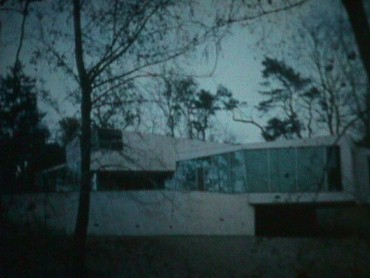 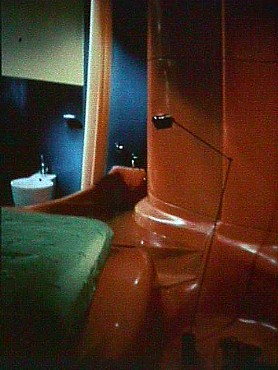 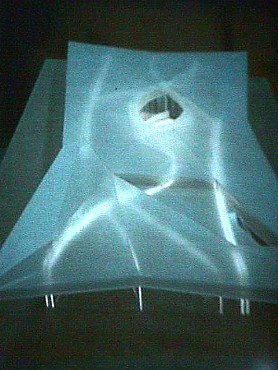
And I think that as good as that is, it's also interesting to see it taken to another level. This is C(?) McDonald's OK Apartment, across Cutner(?) Park in New York. But they actually, I think, in a very imaginative way went outside of normal architectural construction techniques, and engaged with a fiberglass manufacturer that, by the way, completely understood their computer capabilities. If you are talking about topological surfaces, endlessness, seamlessness, obviously moving toward a more liquid application of technology really means a lot. If you have the same formal condition, but you got some guys like cutting out like teeny pieces of wood, you know, with little saws and things, and trying to create this surface by hand in a kind of almost Art Nouveau fashion, you're really kind of falling short of the kind of technological possibilities of what you're actually doing in the office.
I think that this is just kind of beginning. There are some recent developments in the super-concretes that have an enormous elasticity. Whether or not polymers or this type of plastics can ever be expanded on a large scale as architectural surfaces, it's not clear. They're working with the same manufacturer now to do a house addition made out of fiberglass, and it will have an inner and outer shell that they can assemble, so there's an interior surface and an exterior surface. And, quite frankly, these are people that have one employee. They are like completely working with this major manufacturer to develop new architectural responses to what they're trying to get done in the studio. And this is the sort of thing that I think is incredible important for architects, not to leave it at the design stage.
Now this is a great house in design right now by Herzog & de Meuron. It's a family(?) residence to be in the Napa Valley. It's a kind of glass pavilion, and it's a house for a couple that are collectors of video art. So, as you drive in on the property, at a certain point the driveway goes underground, and you arrive below this structure in a darkened atmosphere, where the only presence there is the electronic presence of their video collection, Matthew Barney, Gary Hill, etc., etc. As you're sent up into this pavilion, which is defined by, a rather surprising I suppose for Herzog and de Meuron at a certain point, these undulating lit partitions, which define the separate spaces. These are surfaces also for the projection of video. Now, this is one of those problems ever since, I think the first manifestation of this interest in a media wall, a media skin, a surface to a building that is interactive and capable of receiving information from other sources.
I think it goes back to the ZKM competition, the media museum in Karlsruhe, where both Bernard Tschumi and Rem Koolhaas had facades that were these kind of media walls. This is something that has almost become a generational fascination, but, in fact, it has not been solved. I mean, it is getting more and more sophisticated, but it has not been solved. I don't think architects though can continue to do these media wall presentations without trying to solve it. I do think it's probably going to be very interesting to see how they solve it here at a residential scale -- obviously this is something that is more possible than Karlsruhe would have been.
I think that as we go forward, work, experiments, play, I think these are techniques that need to be recognized and used for what they can, but I think there are other issues also, that is going to be a moment where you really kind of look at which way things are going, what they can be. To be open you have to recognize what is the nature of our interest in these new technologies, and the more you understand why you might be intrigued by them, the more capable you will be of directing them.
We've already discussed the attraction of the new and how that works in architecture as well as other fields. And I think we've also discussed this notion that change is good, and how that somehow reflects an almost crossed ideological position. As Foucault said, there are other forces that are at play -- social utility. I do believe that architects do believe that they can be of some sort of social utility. They have a kind of motive that somehow their work leads to a more broader and more common good, (and I shouldn't have put that directly in opposition to what Foucault said), but I mean in a more innocent way than might have been allowed in that kind of thinking.
I don't think it's the only motivation, but I do think if architects are thinking about social utility, you know, "I want to help, I want to do something good," they have to be very kind about it. And in certain instances, like in the issue of designing a house, topological modeling is very useful in a number of fields, but it has to be admitted that all these fields deal with a level of complexity that is far beyond the problem of a private house. Nonetheless, being useful is not a bad motivation for what architects might be doing with these new technologies. But, having said that, I think altruism is nice and all that, but I think that people have to admit that part of the attraction for these new technologies is aesthetic. I can't remember who said it, and I wish I did because I quote it all the time, but I remember reading that someone said that "architects are secret agents for beauty." Architects really want to do beautiful things, its just that they don't want to talk about it. The last thing in the world that they are going to say is that "what I really want is that this building is really beautiful." We all like it when people say that "gosh, that is fantastic," or "that is just really beautiful," but somehow to want to achieve or to be attracted by what are compelling visual aspects of this technology, is seemingly too cheap or too low for a serious architect. I would really kind of question id altruism can't be let out on too far a leach without questioning what it is that we actually want to do. I think the same kind of repression of the aesthetic and the role that plays in our reorienting ourselves towards the new has to be recognized.
It also has to be recognized that there is a certain kind of competitive(?) aspect for architects in terms of these new technologies. I brought with me the "Weekend" section of the New York Times. I don't know if you've noticed in their new formulation since they've come out with color in that paper, and the new sections, that they've taken what used to be called "The Arts" (. . . I don't remember what it was called before, I think it was actually called "Weekend" section before on Friday . . .), but there used to be one section; now it's two sections. One, the one on the outside, the more important one, is called "Movies & Performing Arts" and there's one, two ,three, four, five, six, seven articles in this section (and here Riley names them). And there is the thinner and interior, and I would say probably growing thinner yet, the "Fine Arts/Leisure" section. And this is things like Monet, Philadelphia Museum of Art, Ellsworth Kelly, etc. And on Sunday you have the "Arts & Leisure" section, and of the twenty-seven articles in the Sunday "Arts & Leisure" section one is on architecture, and two are on museums, traditional museums, Wintertur Museum and the Museum of Contemporary Art, New York, and I don't know what "Flatula, Valves, and Propellers" at the Boston CyberArts Festival is about, but all the rest of them are films, music, television, radio, dance, theater, etc. The point I'm trying to make is that I think the general definition of what art is certainly, if you haven't noticed, moving away from what were called the fine arts before: sculpture, painting, drawing, prints, illustrated books, etc. And, what used to be called fine arts, (the other arts are called performing arts), I think this fine arts are getting redefined as "still arts", the ones that don't move, the ones that don't perform, the ones that might not be . . . I think performance is the key work. I do think that architects feel threatened by this.
I think architects are feeling the possibility of being slightly old fashioned. And it is a real question now, is architecture a still art, or is it one of the old fashioned fine arts? Or, through the media, can it be part of this new kind of performing art. And I think Bilbao is key to understanding this. So, to understand this idea of competition and where it might be leading us, we have to recognized the changed relationship between architecture and the media, and how that effects the perception of architecture by the public. We just had this symposium at MoMA, John Rajchman was moderator, and it was a very interesting session where a number of the leading architects in the world started talking about the "Bilbao effect". I had no idea of how much these architects were not thinking about the building but were thinking about what the building had done to change architectural culture. And Peter Eisenman, who is not very confessional most of the time, I found to be incredibly confessional, admitting that he doesn't know the difference between a theme park and good architecture these days. There is a very fine line between the two, and he finds that his ability to distinguish the two is changing, and he illustrated this by telling the story of being on a jury in Frankfurt where he and one other architect and, in his words, fourteen bureaucrats. There were five architectural projects, he felt that the one was the most radical, and somehow he had to convince the jury that this was "the" radical project. How would he defend it against these bureaucrats? They had a vote, and it was 16-0 in favor of the radical project. All the bureaucrats were saying, "this will be like Bilbao; it will be great; all the tourists will come." Eisenman had a real shock. What he was realizing, of course, was that, well, I'll come back to it later. Frank Gehry himself tells a very similar (in terms of import) story. He was very proud that when EuroDisney was being built, he resisted being given a theme building. He insisted that Bob Stern can do "New York, New York", but "I don't do a theme building." So he was very proud that Disney agree that he could do this space that was about (I don't remember what it was called), but it was a fun place to go, and it was a Frank Gehry building. He said that once he went to see it though, he had a kind of revelation, and he realized that Disney had won, because in that environment, they had gotten him to do a theme building. He did a Frank Gehry theme building. He had become a theme in [Euro]Disney. And it goes on and on, and some these stories . . .
| |
I think it's very enlightening for architects to think about how their work is transmuting in terms of its relationship to the media. There was an article in the Art Newspaper recently by the director of the Victoria and Albert Museum, who has commissioned, as you probably know, Daniel Libeskind to do an addition. Daniel Libeskind believes that his building is a radical new intervention into the staid, old Victoria and Albert culture. The director of the Victoria and Albert says that he's got a list of the two hundred richest people in the world in his briefcase, and he knows that one of them is going to want his name on that building, precisely because it is going to get headlines. So, there's a new relationship, shall we say, between the media and architecture in this instance.
So, what I think is necessary, and you can derive it from what I've been saying, is that it is really important that all the people involved in these new technologies don't fall into the trap of thinking that they're in some new avant-garde that challenges the status quo. What is very evident is that the power structures around the world have already roared their approval of this new technology. If you think that this is about irritating power structures, . . . if you're involved with this new technology in any way, they're going to be knocking on your door. That's not a reason to turn away from them. It's not so terrible that half the mayors of all the rust bucket cities in the world are now thinking of architecture as now the key to their urban problem. Never have architects ever been looked at with so much expectation. However, there is an element of entertainment to this, and entertainment is undeniable architecture's potential hook into global capitalism that is practiced today on a scale that is unprecedented.
Everyone has to recognize that if Microsoft is funding you, and if Disney is paying you, that participation in this process requires a certain surrender of what might be called a critical independence. There will be no more enfant terrible in this scenario. The big question is: what is it that you are willing to negotiate in this arrangement?
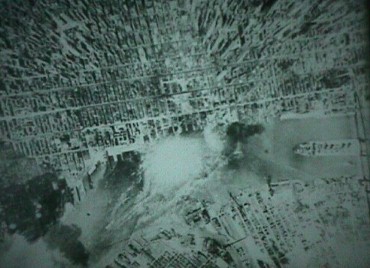 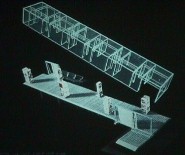 
Finally, I think we have to recognize that the blob versus box argument is intellectually very shallow. These were three separate points; I don't know if they came out that way. This blob versus box argument, if it can be called that, is simply not something that is very serious, and it certainly will not sustain any kind of serious architectural development. There are two (and maybe this is old hat to be talking about boxes versus blobs, but I still seem to hear this and there's something that I just don't understand) things problematic in its formulation. First is the use of the term 'versus' that somehow implies that there is a polemical position somewhere in this argument, and that somehow one or the other form has an ideological advantage over the other one. I don't think that's true, and I don't think you can talk about geometries having absolute fixed meanings in such a way to set up this kind of a dialectic.
I don't have a slide to go with it, but that's obviously a slide of Manhattan on the left in its unrelenting gridiron. If you were to apply adjectives in an accepted formalist language, you would say that this is restrictive, limited, ever kind of adjective to describe repetitive, monotonous, etc., etc. But we all know that this repetitive, monotonous grid is almost synonymous with, and the platform from which one of the most vibrant of urban cultures emerges. And we also know that if I put up a slide of a typical suburban, picturesque landscape it would suggest, diversity, individuality, etc. But, indeed, that kind of geometry as an urban form can be a platform for unrelenting homogeneity.
Other examples, the slide on the left is Bernard Tschumi's Glass Video Pavilion in Brunnegin(sp?) and the slide on the right is the Getz(?) Pavilion for Contemporary Art. I've heard Bernard talk about the Glass Video Pavilion as a deconstructivist exercise, as opposed to the Miesian glass box, which is actually a steel box, this is truly a glass box where the beams and girders are made out of glass, de-emphasizing structure, destabilized, multiple readings, etc., etc. But I've heard Herzog talk about their supposedly neo-modern museum in precisely the same terms. When you look at the thing it looks like a three story building, but then you realize its a two story building. When you think that these patterning indicate some kind of structural arrangement, and then you find out that the structure is actually a truss. That these have to structural bearing whatsoever. Again, there's this whole ambivalence about structure, ambivalence about form. In the normal line-up its hardly ever presumed that there's anything other than a kind of neo-modernism in the Herzog and de Meuron. Which, I think, is an example of how forms can transcend urban . . . -- intentions overcome form.
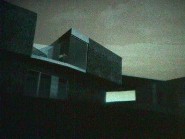 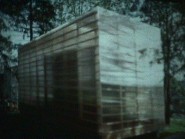 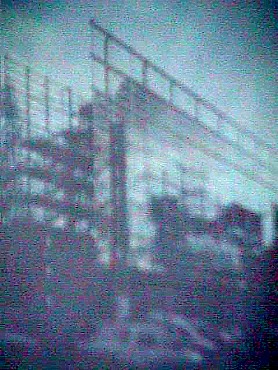
Another series of projects, the slide on your left is by Frogoitti(?) Frogoitti(?) now relocated to London, but formerly out of Cambridge, and the slide on your right is the Leisure(?) Studio from a Group of young architects in Finland. I was recently on a jury at Columbia and all the architecture was topologically generated. Lots of discussion (and I would say very similar to Frogoitti Frogoitti's), where there's an attempt to merge landscape and architecture, non-dialectical approach, more "natural", more "accepting of difference", closer to a natural condition, less directly inside and outside, etc. Ironically, I've heard this Group talk about this Leisure Studio, which is a sauna in the woods, a place to hang out, talk about the same sense -- a place through its transparency captures all the individual differences, and all the panorama of nature, and all the change from dawn to dust, etc., etc. And, it's almost as if the precise same script is being played out as a defense and justification of widely different architectures, proving, I think, the unreliability of using form, blobs or boxes as any kind of indication of where you're going with your work.
Certainly Jean Nouvel's is a classic box, but, as you can see from these slides, as conditioned and as generated as these glass volumes, and volumes, and volumes, almost disappear within their own environment, much less sustaining any kind of dialectical relationship.
The second problematic I have with this box versus blob thing is that it actually implies that they really are two different things, that they are really two different geometric typologies that you're talking about. I think this is a very old fashioned conception, and it reminds me of Leonardo da Vinci writing in the sixteenth century where he said there are basically two types of form. This is amazing that this box and blob dichotomy might have even existed in anyone's mind that long ago, but maybe what's amazing that it still exists in anyone's mind today. He thought that there were two types of form, one was things that had no edges, (a strange formulation), and therefore have no color, no distinct color, and e used clouds as an example. The other form is things that have edges, and therefore have color, (and I think he was thinking in a painterly, planar way). And I think he uses the example of maybe architecture, I'm not sure. Certainly, the computer has shown us that it isn't that Leonardo was right, boxes and blobs almost confirm Renaissance thinking. The difference between a box and a blob obviously is not an ultimate one; it has to do with how you calculate their differences. The computer has made this calculus where it's no longer a great divide between a cloud and a box. It is not a gap, but a slight scale of complexity. To run around reputing some sort of ideological advantage of one over the other is to miss the real leap made by this new technology in terms of calculations. They are really not that different. And to try and sustain an argument that one has a natural ideological advantage over the other is just plain wrong.
What's wrong with boxes? Dare to be square. There are lots of good things about boxes -- they help to make cities. The reason that Manhattan is so dense is because all the buildings have an edge that is similar to the edge of the building next to them. They go together. It's actually a nice thing. It's not even worth arguing. They create density. For the most part they also represent the technologies and eternities(?) that are most applicable to the greatest majority of people and projects everywhere around the world. They also have qualities that are desirable, and that cannot be achieved otherwise. There is a certain presence and feeling in an orthogonal structure that's not the same in a less orthogonal structure. It's simply different, and, again, I fail to see the logic or rationale where one can repute an over-riding advantage of one over the other.
I want to conclude, true heterogeneity. Heidegger, in his essay "The Thing" expresses concern over the way in which the electronic broadcasting of words and images alters our seminal(?) relationships, our distance from events and things. "What is this uniformity in which everything is neither far nor near, is, as it were, without distance. Everything gets lumped together into uniform distancelessness. How is not that merging of everything into the distanceless more unearthly than everything working(?) apart." Heidegger, at his point in the twentieth century was incapable of conceiving was that in our day we would live everyday with the distinction between the virtual and the real. That we would in our waking days have an awareness of these two situations endlessly, back and forth, over and over again. And, I think, and I've heard people try to be cheerleaders for virtual reality as if that was going to be some new state of being that was going to replace realness, and I've also heard a lot of defense for a return back to total reality, almost a neo-Luddite, get rid of the computers sort of thing. The box and the blob almost represents the same sort of stasis in this sense, the inability to imagine a more supple existence where one actually moves in and out, back and forth between varying spaces, and doing so with no ideological change. No alarms going off as one passes from one existence and the other. In truth a truly, truly heterogeneous moment, that can accept both.
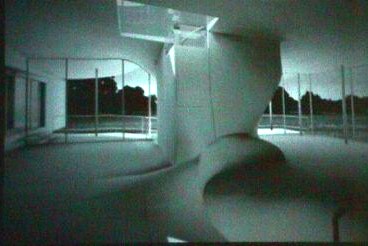
This is Torus House by Scott Cohen, who teaches at the GSD. Here you can see this incredible fusion of normative, Euclidean geometries with topological formations. When I say that we should not dwell excessively on the distinctions between the blobs and boxes, that there is no way of really separating them, I'm suggesting that we should merge into a kind of fog (?) of architectural drool where everything is soupy and the same. Indeed, I don't believe that the use of various and complimentary and additive geometries, whether as exampled here, produce any kind of merger. You don't lose these distinctions, they are actually quite evident, and I think that's what is exciting about it. You discover new and exciting geometric affinities that you never knew existed. And just as . . . I don't know who the mathematician was that started this whole field of inquiry . . . but just as this one mathematician noticed that a coffee cup and a doughnut were actually very similar rather than dissimilar based on their overall configuration, the hole in the doughnut and the hole in the coffee cup handle. For me, Cohen's work has some similarly startling revelations, and what I realized is that by fusing the box, which in this case is really Mies' glass box reborn, and these remnants of the torus shape, this topological form, it made me realize that both of them have some common aspects. One is the sense of boundlessness, whereas the topological forms have this inherently boundless geometric pattern where there's no line, there's no point where these forms start; it's continuously flowing and fluid. Mies' work also had this kind of boundlessness, the attraction to the horizon. Far from seeming foreign, far from seeming unhappy together, Cohen here has demonstrated that these unexpected affinities are actually something that lead us onto the next step, the next level of this discussion.
|









